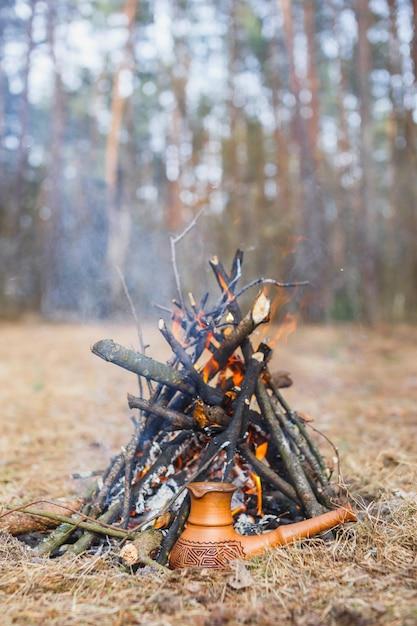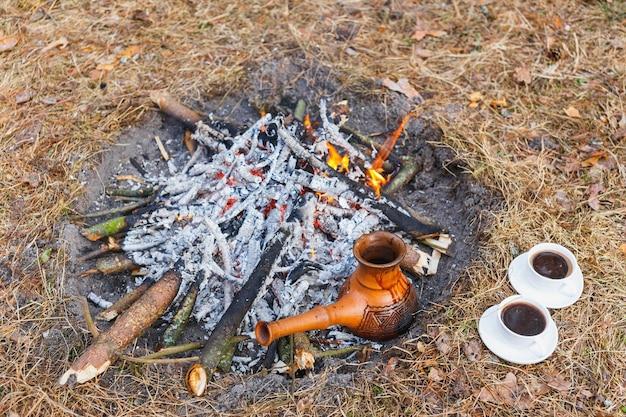Clay is a fascinating material that has been used for various purposes throughout history. From pottery to building materials, clay’s versatility is undeniable. But have you ever wondered what happens to clay when it is exposed to heat? In this blog post, we will explore the transformative process that takes place when clay is heated and discover the answers to some commonly asked questions such as whether clay melts in water, if clay bricks can explode in fire, and what temperature clay turns into ceramic.
So, if you’re curious about what happens when clay is heated and want to understand the science behind it, keep reading. We will delve into the chemical reactions that occur, the changes in physical properties, and the significance of firing clay. By the end of this article, you’ll have a deeper appreciation for the amazing metamorphosis that clay undergoes when subjected to high temperatures.
What Happens When Clay Is Heated
Clay, that versatile material that has been used for centuries in pottery and ceramic art, undergoes a fascinating transformation when exposed to heat. So, what exactly happens when clay is heated? Let’s fire up our curiosity and dive into the kiln of knowledge to find out!
Clay Gets All Fired Up!
When clay is heated, it experiences some intense changes that would rival even the most dramatic soap opera plot twists. The first thing that happens is that the water trapped within the clay starts to evaporate. You can almost hear the tiny water molecules screaming, “I’m free!” as they escape from the clay’s grip.
Hold On Tight, Clay!
As the heat cranks up, the clay starts to get a bit fidgety. Its molecular structure begins to loosen up, and the clay particles start rearranging themselves. It’s like watching a group of people at a party switching partners in a game of musical chairs. Some elements may even start to decompose, depending on the type of clay being heated.
It’s All About That Chemistry, Baby!
Now, here comes the science part. Brace yourself! As the temperature keeps rising, clay minerals go through a process called dehydration. No, they don’t start crying; instead, they lose their chemically bound water molecules. This dehydration dance allows the clay to become more stable and less prone to shrinking or cracking.
And…Action! It’s Time to Get Solid!
As the clay continues to soak in the heat, it eventually reaches a point where its particles fuse together, like the ultimate team-building exercise. This process, known as vitrification, is where the clay becomes solid and non-porous. It’s like a metamorphosis – from a soft, pliable material to a hard, durable masterpiece.
Color Me Fired!
Remember how we mentioned that some elements might decompose earlier? Well, this is where it gets interesting. When heated, different clay types display various colors. For instance, iron-rich clay can turn vibrant shades of red, while clay with manganese can take on hues of purple. It’s like a magical paint palette brought to life by the heat.
Time to Cool It, Clay!
After a scorching journey through the kiln, it’s time for the clay to cool down and relax. As it cools, the clay’s molecules settle into their new arrangement, locking in the shapes and forms created during the firing process. It’s like the perfect ending to a thrilling roller coaster ride.
Heating clay is like giving it a whole new lease on life. From water evaporating, particles rearranging, and minerals undergoing reactions, the transformation is nothing short of remarkable. So, next time you marvel at a beautifully crafted ceramic piece, remember the fiery process that brought it to life – and give a nod of appreciation to clay’s ability to withstand the heat and come out stronger than ever.
FAQ: What Happens When Clay Is Heated
Is Red Clay fireproof
Unfortunately, red clay is not fireproof. When exposed to high temperatures, it can crack, crumble, or even completely disintegrate. So, if you’re planning on using red clay for anything fire-related, you may want to reconsider.
Is terracotta fired
Yes, terracotta is fired clay. It is heated at a lower temperature compared to other types of clay, which gives it its distinctive reddish-brown color. Terracotta is commonly used in pottery and for making flower pots, but it’s not as durable as other types of fired clay.
Which type of clay is heated to very high temperature
If you’re looking for clay that can withstand extreme heat, you’ll want to turn to porcelain or stoneware. These types of clay are fired at much higher temperatures, which results in a stronger and more heat-resistant finished product.
Is heating clay a chemical reaction
Yes, heating clay involves a chemical reaction. When clay is heated, its chemical composition changes. The minerals within the clay undergo structural changes, resulting in the hardening and solidifying of the clay into a ceramic material.
Does Clay melt in water
No, clay does not melt in water. However, it can become soft and pliable when wet, allowing it to be molded into various shapes. Once the water evaporates, the clay will regain its hardness.
Will clay bricks explode in fire
Clay bricks are designed to withstand high temperatures, so they won’t explode in a fire. However, if the bricks contain any moisture, they can crack or break due to the rapid expansion of steam. It’s best to ensure clay bricks are thoroughly dry before exposing them to extreme heat.
What temperature does clay turn into ceramic
Clay turns into ceramic when it goes through a process called firing. The exact temperature at which this transformation occurs depends on the type of clay, but it typically ranges from 1800 to 2400 degrees Fahrenheit (982 to 1316 degrees Celsius).
What happens if you fire wet clay
Firing wet clay is a recipe for disaster. Any water trapped within the clay will rapidly turn into steam during the firing process. This can cause the clay to crack, explode, or even break apart completely. It’s crucial to let clay dry thoroughly before subjecting it to high temperatures.
How long can clay sit before firing
Clay can generally sit for several weeks or even months before firing without any issues. However, it’s important to keep it covered and prevent it from drying out too much. If clay becomes too dry, it may require rehydration or kneading to restore its workability.
How much heat can a red brick withstand
Red bricks are quite resilient when it comes to heat. They can typically withstand temperatures of up to 2000 degrees Fahrenheit (1093 degrees Celsius) without significant damage. This is why they are commonly used in fireplaces and kilns.
What kind of clay does not need to be fired
Air-dry clay is a type of clay that does not require firing. It air dries and hardens over time, eliminating the need for a kiln or high temperatures. It’s a convenient option for crafting projects, but keep in mind that it may not have the same durability as fired clay.
What temperature should Terracotta be fired at
Terracotta is typically fired at temperatures ranging from 1800 to 2000 degrees Fahrenheit (982 to 1093 degrees Celsius). This lower firing temperature gives terracotta its unique reddish-brown color and characteristic porous quality.
Does terracotta clay need to be fired
Yes, terracotta clay needs to be fired to achieve its final, durable state. Firing helps remove any remaining moisture and strengthens the clay, making it suitable for various applications such as pottery and architectural features.
Why is clay fired
Clay is fired to transform it into a durable and usable material. Firing removes water, burns off organic materials, and causes chemical reactions that alter the clay’s composition. The result is a hardened ceramic material that can be utilized in numerous ways.
How thick can clay be without exploding
The thickness of clay has a significant impact on its ability to withstand heat without exploding. As a general guideline, it’s recommended to keep the thickness of clay objects below 1 inch (2.5 centimeters) to reduce the risk of them cracking or bursting during firing.
Can you burn clay
Technically speaking, clay cannot burn because it’s already been fired in a kiln. However, if you’re referring to using clay as a fuel source, then yes, it can burn. Clay can be used to make kiln bricks or create clay ovens, where the heat generated from burning other materials can be retained.
What causes clay to explode when heated up
Clay explodes when heated up due to the presence of moisture. As the clay heats, any trapped water turns into steam, which rapidly expands, creating pressure within the clay. This pressure buildup can lead to cracks, bursts, or the complete destruction of the clay object.
Can I use red clay bricks for a fire pit
While red clay bricks are often used for construction purposes, they may not be the best option for a fire pit. Although they can withstand high temperatures, they are more susceptible to damage from moisture. Consider using fire bricks specifically designed for withstanding extreme heat.
Does clay turn into glass
No, clay does not turn into glass when heated. Glass is made from a completely different material—silica—while clay consists of various minerals. However, clay can be used in the creation of ceramics, which have some similar properties to glass such as hardness and brittleness.
What happens when wet clay gets heated too quickly
Heating wet clay too quickly can cause it to crack, explode, or even shatter. The sudden exposure to high temperatures causes the water within the clay to turn into steam rapidly. This steam expansion creates excessive pressure, leading to the clay’s destruction.
How can you tell if Clay is vitrified
To determine if clay is vitrified, you can examine its surface. Vitrified clay has a smooth and glass-like appearance. Additionally, you can lightly tap a ceramic made from the clay and listen for a ringing sound. Vitrified clay produces a clear and resonant ring, indicating its strong and nonporous nature.
Now that you’re armed with knowledge about what happens when clay is heated, you can experiment with different types of clay and firing techniques. Remember, patience and proper care are essential to ensure your clay creations turn out beautifully in the heat of the kiln. Happy firing!
Note: Information provided in this article is accurate as of 2023 and may be subject to change in the future.

